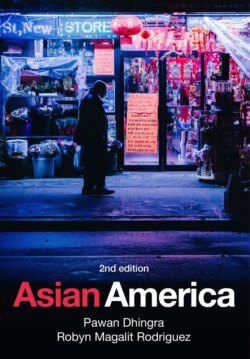Читать книгу Asian America - Pawan Dhingra - Страница 32
Race as a social construction
ОглавлениеIn the United States, when we see someone, we generally think we can identify that person’s “race.” In fact, whether we are fully conscious of the fact that we are doing it, many of us who have spent a significant portion of our lives in the United States immediately attempt to categorize the people we encounter every day into a specific race. Race is such a significant way of organizing and categorizing people in American society that we are often confounded when we encounter a person whose “race” we cannot immediately make sense of. People typically “look” Asian or Native American or black or white or Latinx.1 People have distinguishable skin tones, hair textures, facial features, eye contours. These are biologically based. So how is race a social construction? While people have genetic distinctions, it is not the case that people classified as the same “race” have more in common genetically with one another than with those of different races.2 There is no single gene particular to one race. The physical differences that are seemingly apparent between races, such as skin color, have no bearing on other characteristics, such as intelligence, skills, and so on. These physical differences stem from the geographic regions of origin of one’s ancestors. Yet, in American society, these physical differences have been used to differentiate people into separate groups such as white, black, or Asian, both on an everyday level and at the level of government classification. Moreover, these categorizations are ordered in hierarchical ways, which has resulted in people being treated unequally.
Race developed as a way of distinguishing people from European colonial times (Feagin 2009; Prashad 2000). Colonizers used phenotype as a way to differentiate themselves from the colonized and to rationalize the exploitation of people considered morally different by mere fact of their phenotypic difference. Race developed as a concept, and notions of racial difference and hierarchy emerged in order to justify the slavery of Africans in the United States. In other words, race and racism did not lead to slavery as much as slavery led to racial formations and racism. Race similarly was used to define Native Americans, Latinxs, and Asian Americans as in some way deviant and threatening to white Europeans in order to secure greater resources (e.g. land, jobs, higher wages, better work conditions, etc.). Racial difference created and continues to sustain privileges for some and disadvantages for others. Specifically, because race as a concept emerged in the context of European colonialism, it is organized around a logic of white supremacy, that is, those who are considered white are considered intellectually and morally superior over those who are nonwhite. Minority groups are racialized differently so as to support various aspects of white supremacy (Smith 2015). For instance, blacks are framed as physically strong, lower skilled, and less deserving in order to justify racial capitalism that positions them as poorly paid and incarcerated labor. Asian Americans are racialized as foreigners, as threats to the nation, and as morally backwards in order to justify American military power and white-racial conquest. For most sociologists, it is important to understand racism not simply as a form of individual prejudice (i.e. ill-informed, preconceived notions of people) but from a structural perspective (Bonilla-Silva 1997).
Racial classifications have changed historically, further indicating that racial categories are a political and social invention rather than biologically based. For instance, Irish Americans always have been phenotypically white but were not always considered “racially” white (Ignatiev 1995). In the mid-1800s, Irish Americans were considered more akin to African Americans than to free whites. African Americans were even referred to as “smoked Irish.” Only after Irish Americans took jobs that distinguished them from African Americans, endorsed slavery (despite Irish leaders’ condemnation of the practice), and joined the dominant white voting blocs did they become accepted as “whites.” Chinese Americans in Mississippi in the late 1800s also shifted their informal racial status from black to white (Loewen 1971). They became small-business owners and gradually associated more with whites rather than blacks, allowing them to be perceived by others as nonblacks and so closer to whites. More recently, in the 1970s, Indian Americans petitioned to have their race changed in the US Census from white to Asian American (Das Gupta 2006). They believed that their racialized experiences best resembled that of other Asian Americans, and there were economic and political gains in being designated a racial minority, such as more attractive small-business loans. Across these changes, however, the centrality and taken-for-granted normalcy of whites are not questioned.
If we take a comparative perspective and examine how racial categories are assigned in countries beyond the United States, it becomes even clearer how race is socially constructed. People who may appear to share the same phenotypic features and might be categorized in a similar way in the United States (say, as “black”) in a country like Brazil may actually be divided into different categories (Telles 2004).
Online resource: For a discussion of how racial categories have changed in the US Census and how US racial categorization compares with racial categorization in Brazil, see https://www.psychologytoday.com/us/blog/looking-in-the-cultural-mirror/201112/what-does-the-brazilian-census-tell-us-about-race
Race is a politically created concept. Racial categories are externally imposed, and groups must navigate within and between them. Groups with greater power over social discourse, media, and the economy assign the racial categories of a society, and minorities attempt to jockey for position within those options. Members of the same race may have nothing in common except for a shared phenotype (and, even then, those phenotypes are not actually identical). This process of being externally assigned a racial group is an example of racial formation.
